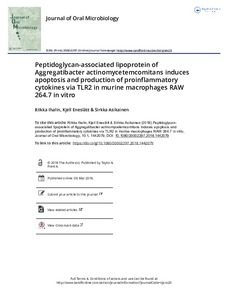Peptidoglycan-associated lipoprotein of Aggregatibacter actinomycetemcomitans induces apoptosis and production of proinflammatory cytokines via TLR2 in murine macrophages RAW 264.7 in vitro
Sirkka Asikainen; Riikka Ihalin; Kjell Eneslätt
Peptidoglycan-associated lipoprotein of Aggregatibacter actinomycetemcomitans induces apoptosis and production of proinflammatory cytokines via TLR2 in murine macrophages RAW 264.7 in vitro
Sirkka Asikainen
Riikka Ihalin
Kjell Eneslätt
Taylor & Francis
Julkaisun pysyvä osoite on:
https://urn.fi/URN:NBN:fi-fe2021042718803
https://urn.fi/URN:NBN:fi-fe2021042718803
Tiivistelmä
Peptidoglycan-associated lipoprotein (PAL) is a conserved
pro-inflammatory outer membrane lipoprotein in Gram-negative bacteria.
Compared to systemic pathogens, little is known about the virulence
properties of PAL in Aggregatibacter actinomycetemcomitans
(AaPAL). The aims of this study were to investigate the cytolethality of
AaPAL and its ability to induce pro-inflammatory cytokine production in
macrophages. Mouse macrophages were stimulated with AaPAL, and the
production of IL-1β, IL-6, TNF-α, and MCP-1 was measured after 6, 24,
and 48 h. To investigate which receptor AaPAL employs for its
interaction with macrophages, anti-toll-like receptor (TLR)2 and
anti-TLR4 antibodies were used to block respective TLRs on macrophages.
Metabolic activity and apoptosis of the macrophages were investigated
after stimulation with AaPAL. AaPAL induced the production of MCP-1,
TNF-α, IL-6, and IL-1β from mouse macrophages in order of decreasing
abundance. The pre-treatment of macrophages with an anti-TLR2 antibody
significantly diminished cytokine production. Under AaPAL stimulation,
the metabolic activity of macrophages decreased in a dose- and
time-dependent manner. Furthermore, AaPAL induced apoptosis in 56% of
macrophages after 48 h of incubation. Our data suggest that AaPAL can
kill macrophages by apoptosis. The results also emphasize the role of
AaPAL as a potent pro-inflammatory agent in A. actinomycetemcomitans-associated infections.
pro-inflammatory outer membrane lipoprotein in Gram-negative bacteria.
Compared to systemic pathogens, little is known about the virulence
properties of PAL in Aggregatibacter actinomycetemcomitans
(AaPAL). The aims of this study were to investigate the cytolethality of
AaPAL and its ability to induce pro-inflammatory cytokine production in
macrophages. Mouse macrophages were stimulated with AaPAL, and the
production of IL-1β, IL-6, TNF-α, and MCP-1 was measured after 6, 24,
and 48 h. To investigate which receptor AaPAL employs for its
interaction with macrophages, anti-toll-like receptor (TLR)2 and
anti-TLR4 antibodies were used to block respective TLRs on macrophages.
Metabolic activity and apoptosis of the macrophages were investigated
after stimulation with AaPAL. AaPAL induced the production of MCP-1,
TNF-α, IL-6, and IL-1β from mouse macrophages in order of decreasing
abundance. The pre-treatment of macrophages with an anti-TLR2 antibody
significantly diminished cytokine production. Under AaPAL stimulation,
the metabolic activity of macrophages decreased in a dose- and
time-dependent manner. Furthermore, AaPAL induced apoptosis in 56% of
macrophages after 48 h of incubation. Our data suggest that AaPAL can
kill macrophages by apoptosis. The results also emphasize the role of
AaPAL as a potent pro-inflammatory agent in A. actinomycetemcomitans-associated infections.
Kokoelmat
- Rinnakkaistallenteet [27094]
